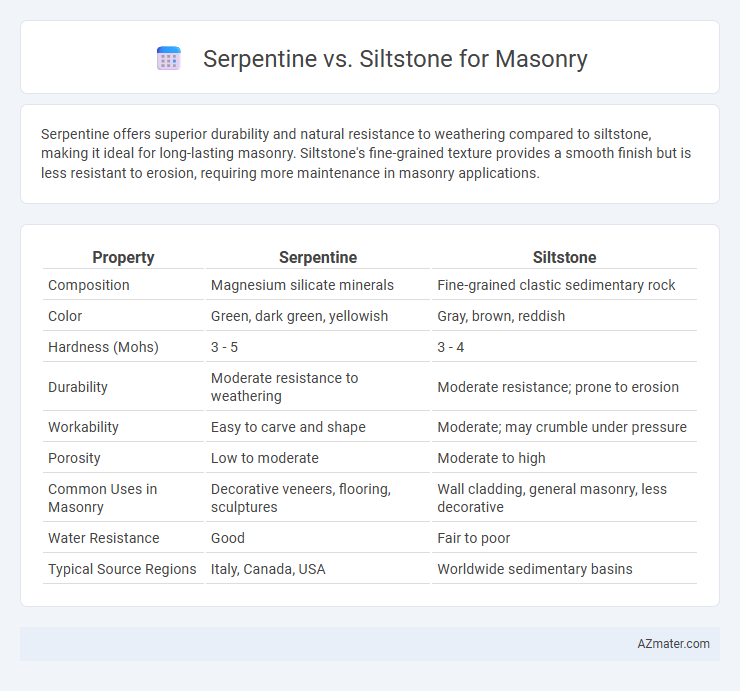Serpentine offers superior durability and natural resistance to weathering compared to siltstone, making it ideal for long-lasting masonry. Siltstone's fine-grained texture provides a smooth finish but is less resistant to erosion, requiring more maintenance in masonry applications.
Table of Comparison
| Property | Serpentine | Siltstone |
|---|---|---|
| Composition | Magnesium silicate minerals | Fine-grained clastic sedimentary rock |
| Color | Green, dark green, yellowish | Gray, brown, reddish |
| Hardness (Mohs) | 3 - 5 | 3 - 4 |
| Durability | Moderate resistance to weathering | Moderate resistance; prone to erosion |
| Workability | Easy to carve and shape | Moderate; may crumble under pressure |
| Porosity | Low to moderate | Moderate to high |
| Common Uses in Masonry | Decorative veneers, flooring, sculptures | Wall cladding, general masonry, less decorative |
| Water Resistance | Good | Fair to poor |
| Typical Source Regions | Italy, Canada, USA | Worldwide sedimentary basins |
Introduction to Serpentine and Siltstone in Masonry
Serpentine and siltstone are popular choices in masonry due to their distinct geological properties and aesthetic appeal. Serpentine, a metamorphic rock rich in magnesium silicate minerals, is prized for its greenish hues and smooth texture, making it suitable for decorative and structural applications. Siltstone, a sedimentary rock composed primarily of fine silt-sized particles, offers durability and a variety of earthy colors, often used for cladding, paving, and other architectural features.
Geological Formation and Composition
Serpentine forms from the hydration and metamorphic transformation of ultramafic rocks, primarily composed of magnesium silicate minerals, giving it a distinctive greenish hue and a relatively soft texture ideal for ornamental masonry. Siltstone originates from compacted silt-sized sediment particles, mainly quartz and feldspar, resulting in a fine-grained, durable sedimentary rock with excellent compressive strength suitable for structural masonry. The contrasting geological formation processes and mineral compositions influence their respective durability, weather resistance, and aesthetic qualities in construction applications.
Physical Properties Comparison
Serpentine and siltstone differ significantly in physical properties impacting masonry applications; serpentine is characterized by a softer hardness (Mohs scale 2.5-4) and higher flexibility, while siltstone exhibits greater hardness (Mohs scale 3-4) and compactness, contributing to enhanced durability. Serpentine's lower density and porous structure may result in increased water absorption, affecting weather resistance, whereas siltstone's fine-grained texture delivers better compression strength and less permeability. These distinctions influence their suitability: serpentine is preferred for ornamental and lightweight masonry, whereas siltstone offers superior structural integrity for load-bearing constructions.
Durability and Weather Resistance
Serpentine exhibits moderate durability with good resistance to weathering, but its susceptibility to chemical breakdown under acidic conditions limits its long-term performance in masonry applications. Siltstone, characterized by fine-grain sedimentary composition, demonstrates higher durability and superior weather resistance due to its dense, compact structure and low porosity. Selecting siltstone for masonry provides enhanced structural integrity and longevity in environments exposed to rain, frost, and temperature fluctuations.
Workability and Cutting Ease
Serpentine offers superior workability and cutting ease compared to siltstone due to its softer mineral composition and fine grain structure, allowing smoother shaping and detailing in masonry projects. Siltstone's hardness and compact nature make it more challenging to cut and shape, often requiring specialized tools and increased effort. These properties make serpentine a preferred choice for intricate masonry work where precision and ease of manipulation are critical.
Aesthetic Appeal and Color Variations
Serpentine offers a rich palette of deep greens, yellows, and browns with a distinctive swirling pattern that enhances masonry with a natural, vibrant aesthetic. Siltstone provides more subdued, earthy tones ranging from light grays to warm reds, contributing to a timeless and classic appearance in stonework. The dynamic color variations in serpentine create striking visual interest, while siltstone's uniform hues deliver consistent elegance in architectural applications.
Common Uses in Masonry Projects
Serpentine is commonly used for decorative masonry due to its attractive green hue and smooth texture, often featured in interior wall cladding, countertops, and ornamental stonework. Siltstone serves primarily in structural masonry, offering durability and ease of cutting for building blocks, paving stones, and retaining walls. Both materials provide unique aesthetic qualities and functional benefits, with serpentine favored for its visual appeal and siltstone prized for its strength and weather resistance.
Cost and Availability Analysis
Serpentine offers moderate cost advantages over siltstone due to its widespread occurrence in regions like the Eastern United States and parts of Canada, making it more readily available for masonry projects. Siltstone, often sourced from sedimentary deposits in areas such as the Midwest and Northern Europe, may incur higher transportation costs, influencing overall expenditure. Availability variability and quarrying accessibility significantly impact the cost efficiency between serpentine and siltstone in masonry applications.
Environmental Impact and Sustainability
Serpentine and siltstone differ significantly in environmental impact and sustainability when used in masonry. Serpentine, often rich in magnesium, can host chrysotile asbestos fibers, raising concerns about hazardous dust during quarrying and cutting, while its moderate durability supports longevity in construction. Siltstone, primarily composed of fine sedimentary particles, generally poses fewer health risks and offers better recyclability and lower embodied energy, contributing to more sustainable masonry solutions with reduced ecological footprints.
Choosing the Right Stone for Your Project
Serpentine offers a unique aesthetic with its rich green hues and smooth texture, making it ideal for decorative masonry where visual appeal is a priority. Siltstone provides superior durability and resistance to weathering, making it a practical choice for structural walls and outdoor installations requiring long-term strength. Evaluating project requirements such as load bearing, environmental exposure, and desired appearance ensures the selection of serpentine or siltstone aligns with both functional and design goals.

Infographic: Serpentine vs Siltstone for Masonry
 azmater.com
azmater.com